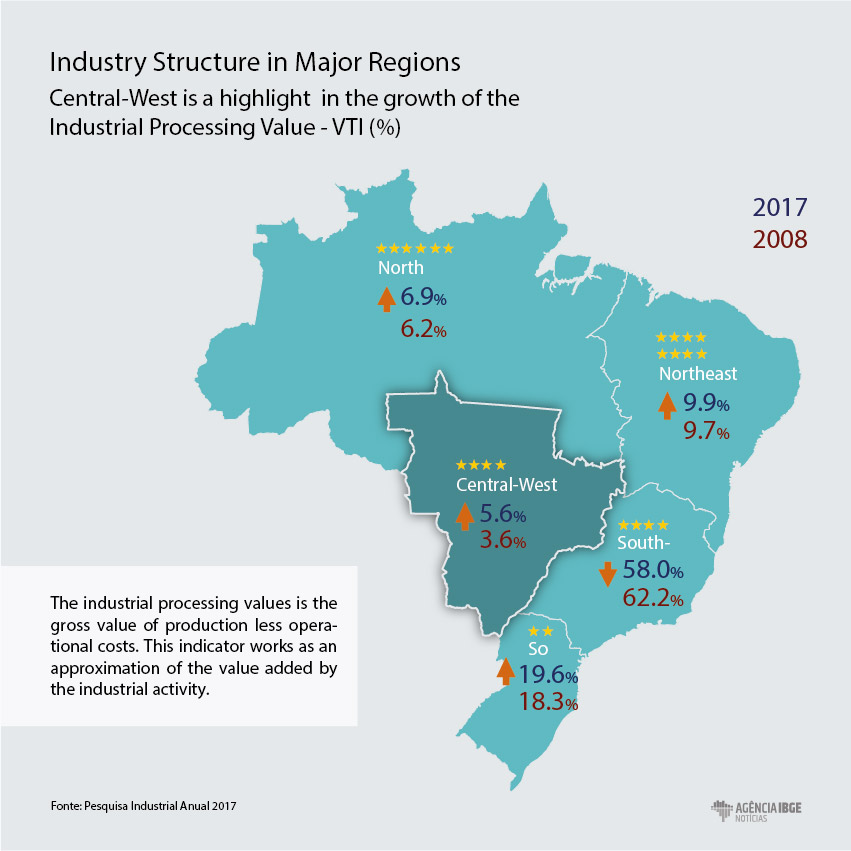Annal Survey of Industry
Industry lost 1.3 million jobs in four years
June 06, 2019 10h00 AM | Last Updated: December 17, 2021 12h37 PM

The industry lost 14.8% of jobs between 2013 and 2017, representing 1.3 million workers. Employment in industry fell throughout the period, although the decline in 2017 was the least intense, accounting for a decline of 0.6% or 44.5 thousand jobs. The year in which the Brazilian industry had the highest number of employees was 2013, with about 9.03 million employed persons. This is what the Annual Survey of Industry (PIA), released today by IBGE, reveals.
As to the wages paid by the industry in real terms, the fall reached 14.7%, on average, since 2014. Once again, the wage loss in the mining and quarrying industries (-31.2%) was much higher than in the manufacturing industries (-13.9%). Concerning the general industry net sales, there was also a decline in real terms of 7.7% between 2014 and 2017. In the mining and quarrying sector (-16.9%) the loss was sharper than in the manufacturing industries (-7.4%).
Changes in wages and revenues were calculated, respectively, based on the National Consumer Price Index (INPC) and the Producer Price Index (IPP), which incorporated the mining and quarrying industries in 2014.

Central-West participation in industry boosts
Although it has lost its representativeness over the last ten years, the Southeast accounted for 58% of the value of the industrial manufacturingh in 2017, remaining as the leader, followed by the South (19.6%), the Northeast (9.9%), North (6.9%) and Central-West (5.6%). Since 2008, there has been a decline of 4.2 pp in the Southeast participation, in favor of the Central-West Region, which had the largest advance (1.9 pp), followed by the South (1.3 pp).
This productive shift was mainly due to the migration of agroindustrial plants that were dedicated to the manufacture of food products and began to produce biofuels, making this activity one of the three most relevant in the area.
The value of the industrial manufacture is the gross value of the production minus the operational cost, and it works as a figure close to the value added by the industrial activity.

New industrial activities are a highlight in the North and Northeast
From 2008 to 2017, the North and Northeast Regions showed the highest number of industrial activities introduced for the first time among the three with the highest values of industrial manufacturing in each state: eight in the Northeast and six in the North.
Among the highlights of the Northeast, is the manufacture of coke, petroleum products and biofuels, which took the lead of the Rio Grande do Norte industry, with 25.6% of the industrial value of this state. In Maranhão, the production of pulp and paper already represents 22.6%, followed by the extraction of oil and gas (9.1%), another newcomer among the top three. In Pernambuco, the manufacture of coke, petroleum products and biofuels joins motor vehicle manufacturing, accounting for 11.8% and 10.9% of the local industrial manufacturing value, respectively. Of the nine states in the Northeast, only Paraíba and Sergipe did not have new industrial activities among the three most important.
In the North, five of the seven states had new activities among those with the three highest values of industrial manufacturing. The highlight was Amapá, where basic metals (26.1%) and food products (16.7%) already represent almost 43% of the value of local industrial manufacturing. In Amazonas, beverage production (21.5%) is the second place among the three largest. In Tocantins, the production of coke, petroleum products and biofuels represents 10.8%.



















